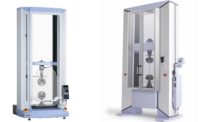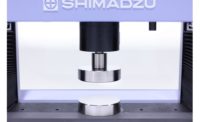Back to Basics: Material Testing Carbon Fiber Reinforced Plastics
An expert explains how to transition from testing polymers and metals to CFRPs.

Carbon fiber reinforced plastics, or CFRPs, are found throughout the aerospace and automotive industries, as well as in high-performance sporting goods, due to their light-weight, high-strength properties.
“Compared to traditional rigid plastics, they have a really heavily increased strength to weight ratio,” explains Matt Riley, Ph.D., assistant professor in the department of mechanical engineering at the Rose-Hulman Institute of Technology. “Compared to metals, they’re not typically orders of magnitude stronger, but it’s that strength-to-weight ratio that gives you the big benefit.”
As the name suggests, CFRPs consist of a polymer reinforced with thin strands of carbon fiber woven in a specific direction. Unlike isotropic materials such as rigid plastics or metals, CFRPs are anisotropic and only possess strength in the direction of the woven fiber. CFRPs’ anisotropic nature provides both its advantageous material properties and inherent complexities that should be taken into consideration when testing.
“You can basically design CFRPs to be incredibly strong in just one or a limited number of directions,” explains Riley. “By only tailoring it to be strong in that one or two directions, you can get that really dramatic increased weight savings, because you don’t have to make it equally strong in every single direction, like an isotopic material like a plastic or a metal.”
Manufacturing Variability
CFRPs are more sensitive to their manufacturing conditions than traditional polymers, which are reliably and repeatedly molded with predictable results, explains Riley. “With CFRPs there’s a lot more variability from sample to sample as a function of your manufacturing approach, and that’s where a lot of the difficulty comes into play. That introduces a lot of uncertainty in the final product.”
The often inconsistent nature of CFRPs adds importance to testing to ensure that the material behaves as predicted. For an engineer familiar with testing polymers and metals for varying material strength, there is also additional nuance required for drawing a complete portrait of a CFRP sample’s material properties, due to its anisotropic nature and more complex structure.
“You want to be able to capture the appropriate level of uncertainty that might exist in the results [manufacturers] publish,” he says. “The secondary reason, and I would say actually for a lot of people I talk to this is the number one reason why they eventually get into testing these things, is because these CFRPS are so anisotropic in nature it’s really just infeasible for the manufacturer to actually present every single material property.”
In place of presenting every material property of the CFRP, manufacturers will instead list a basic subset of constituent properties, he says, such as the strength of the fibers, the strength of the matrix, and the longitudinal modulus of the fibers. Then an engineer will determine the specific strengths or moduli of the CFRP that they need to know in order to design or implement the component.
Testing
Technicians or engineers making a transition from testing polymers and metals to CFRPs should remember that many tests commonly performed for isotropic materials won’t necessarily completely characterize a material that’s anisotropic, such as a CFRP, says Riley.
“So if you’re testing a material that was presumably isotropic, you could just run a tensile test,” he says. “And if you had it instrumented to the point that you could get your longitudinal and your latitudinal placement of your test specimen, you could theoretically get every single material property—or at least your basic mechanical properties—out of one test. You could get all your moduli, your Poisson's ratio, your shear modulus, your strength.
“But when you’re dealing with CFRPs that are designed to be anisotropic in nature, instead of there being one elastic modulus like there would be in something like a polymer, there are actually a total of three of them. And instead of there being one Poisson’s ratio, there are actually three of them, and instead of there being one shear modulus, there are three of them. There’s a lot more that actually needs to be characterized than there traditionally would in an isotropic material.”
In order to fully characterize a CFRP sample’s properties, a technician or engineer needs to run tests in all three orthogonal axes. To achieve this, multiple test samples can be cut from one large sheet of CFRP laminate, with each sample cut at different angles in relation to the direction of the carbon fiber weave. Each test angle is then repeated at least three times, generally, though the precise requirements are defined by ASTM depending on the test and specific material.
Technicians and engineers should expect CFRPs to behave differently in tests than more traditional materials. Consider a flexural test. With an isotropic polymer, generally speaking, the elastic moduli will often be the same for both bending and stretching.
“But for something that’s anisotropic, like CFRPs, those are actually two different values. There’s going to be a different stiffness of the material in tension. In addition, there are also different failure modes that occur,” explains Riley. “A polymer will typically have the same failure mode in bending as it would in tensile loading. But a CFRP could have multiple modes of failure.”
In tensile testing, the failure mode could be caused by the load pulling carbon fibers out from the polymer matrix, or the test could fracture the fiber. When bending the same CFRP, an often-missed failure mode is called delamination, or when the laminate layers peel apart due to the shear stresses that happen at the surface. It’s a failure mode that would not happen with a pure polymer.
“The main piece of advice that I would give to someone looking to make that transition [from polymers or metals to CFRPs] would be to understand the anisotropic nature of it, and to at least understand the additional complexities that introduces,” Riley says. “Also recognize that it’s not a bad thing. It gives you a lot more capabilities as a designer to actually make the CFRP component suitable for your specific application without over-designing it for other loading scenarios that it might not actually encounter in its operation.”
Looking for a reprint of this article?
From high-res PDFs to custom plaques, order your copy today!







